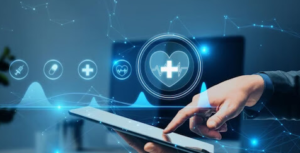
Technology Improves Healthcare Service Access
Technology has fundamentally changed several facets of our life in recent years; among them, healthcare is one of the most affected industry. Technology is changing our access to and experience with healthcare services from electronic health records to telemedicine. This paper explores how technology improves access to healthcare services by means of benefits, problems, and future possibilities.
The emergence of telemedicine
Telemedicine : What is it?
Telemedicine is the application of technology to remotely administer medical treatment. Virtual consultations, remote monitoring, and even digital prescriptions can all fit under this heading. Telemedicine has let patients get medical treatment without leaving their homes by using video calls, smartphone apps and other digital technologies.
advantages of telemedicine: more accessibility
The capacity of telemedicine to boost accessibility is among its most important advantages. Accessing quality treatment presents difficulties for those from underprivileged or remote areas. By letting individuals see general practitioners and experts from the comfort of their homes, telemedicine closes this distance.
2. Simplicity
Telemedicine provides unmatched convenience. Usually without extensive wait times, patients can arrange visits at times that best for them. Those with hectic lives, chronic illnesses or mobility problems in particular will find this especially helpful.
3. Money Saving
Additionally resulting in cost savings for patients and healthcare professionals is telemedicine. For patients, it saves time spent away from work and removes the necessity for travel. For medical professionals, it can reduce overhead related to keeping actual office space.
Obstacles and Issues and Thoughtfulness
1. Barriers to Technology
Telemedicine has certain difficulties even if it offers benefits. For certain patients, access to dependable technology and internet could prove challenging. Making sure everyone has the tools required to engage in telemedicine is absolutely vital.
2. Security and Privacy
Ensuring patient data’s privacy and security becomes increasingly crucial as digital health records and virtual consultations become more common. Strong cybersecurity policies have to be followed by healthcare professionals to guard private data.
E-health records or EHRs
Electronic Health Records are what?
Electronic Health Records (EHRs) are computerized copies of medical records for individual patients. EHRs enable more coordinated and effective treatment by allowing diverse healthcare professionals to quickly share data unlike paper records allow.
Advantages of EHRs 1. Enhanced care coordination
1.EHRs let several healthcare practitioners access the same patient information, therefore improving the coordination of treatment. Better decisions, less duplication of testing and more coherent treatment regimens can result from this as well as from other changes.
2. Improved correctness
EHRs help to lower mistakes connected with handwritten notes. Embedded in EHRs, automated warnings and decision support systems enable medical professionals make more accurate diagnosis and treatment recommendations.
3. Involvement of the Patients
Patient portals which let people access their own medical records, make appointments, and interact with their doctors often find place on EHR systems. Greater patient involvement and empowerment follow from this.
Difficulties and Thoughts to Remember
1. Execution expenses
For smaller clinics specifically, implementing EHR systems can be expensive for healthcare professionals. Still, the long-term advantages of better efficiency and coordination of services usually exceed the initial cost.

2. Information Safety
With EHRs, data security is a major issue much as with telemedicine. Maintaining patient confidence and confidentiality depends on EHR systems being kept safe against leaks.
Applications in Mobile Health (mHealth)
What is mHealth?
Mobile health, sometimes known as mHealth, is the application and device use supporting healthcare services. From fitness monitors to medicine reminders and assistance for managing chronic illnesses, these devices can range.
1.MHealth’s advantages include: health monitoring
mHealth apps let consumers track many facets of their health, including blood glucose levels, heart rate, and physical activity. This ongoing observation can enable people with chronic diseases better control them.
2. Medication Handling
Although a regular difficulty, medication adherence can be improved with mHealth tools. These programs may track doses, remind users to take their meds, and even offer details on possible drug interactions.
3. Training in Health
Many mHealth apps provide tools and instructional materials to enable users to grasp and control their medical issues. Better informed patients who are more proactive about their health can result from this.
Obstacles and Issues and Thoughtfulness
1. App Compliance and Control
mHealth apps might have very different quality. Certain programs could not have clinical validation or scientific support. Users should be able to access dependable, evidence based tools without fail.
2. Personal Privacy
Data privacy remains a major concern even with the gathering of personal health data via mHealth apps. Maintaining confidence depends on these apps following rules and safeguarding of user data.
AI in Healthcare: Artificial Intelligence
1.AI Use in Medical Fields
With its capacity to evaluate enormous volumes of data and generate predictions, artificial intelligence (AI) is causing waves in healthcare. In healthcare, artificial intelligence finds use in diagnosis instruments, tailored treatment programs and even robotic operations.
AI’s advantages include improved diagnosis.
Medical photos and data may be analyzed by artificial intelligence algorithms far faster and more precisely than human vision alone. Early diagnosis of diseases including cancer can result from this, therefore enhancing patient outcomes.
2. Individualized Medication
Based on their particular genetic makeup and medical history, artificial intelligence can assist to customize therapy strategies for every patient. More efficient therapies and improved patient outcomes are possible from this tailored strategy.
3. Operational Proficiency
Administrative chores such health record management, billing and scheduling can also be streamlined by artificial intelligence. This helps healthcare professionals to focus more on patient care and lessens their workload.
Difficulties and Thoughts to Remember
1.Legal and ethical questions
Using artificial intelligence in healthcare begs ethical and legal questions include the possibility of biassed algorithms and the need of openness in AI decision-making procedures.
2. Data Privacy
Large datasets are sometimes required by AI systems, which begs issues of data security and privacy. AI systems must be sure they follow strict data protection guidelines.
Utilizing Virtual Reality (VR) and Augmented Reality (AR) for Medical Applications
Definitions of VR and AR:
Immersion technologies called virtual reality (VR) and augmented reality (AR) can replicate digital data onto the physical world or generate simulations. These technologies find usage in healthcare for diagnosis, patient treatment and training.
Advantages of VR and AR
1. Medical Training
Realistic simulations for medical education can come from VR and AR. In a controlled, virtual environment, trainees can hone their surgical techniques and other medical skills, therefore strengthening their confidence.
2. Therapeutic Management of Pain
Immersion distraction experiences from VR have demonstrated to assist control pain. Patients experiencing uncomfortable treatments or chronic pain management may especially benefit from this.
3. Improved Treatments and Diagnosis
AR overlays digital information onto a patient’s body to help diagnose and cure diseases. AR can enable surgeons, for instance, see interior structures during operation.
Difficulties and Notes of Reference
1. Availability and Cost
Implementing VR and AR technologies can be costly, so their accessibility in particular healthcare environments may be restricted. This might alter, though, as technology develops and gets more reasonably priced.
2. technical difficulties
Effective usage of VR and AR systems depends on their technological dependability and accuracy, so these aspects are absolutely important in healthcare. To meet these obstacles, constant development and testing are required.
Emerging Trends in Technology’s Future in Healthcare
Future developments in technology in healthcare seem to be even more remarkable. On horizon are trends including enhanced robotics for surgery, blockchain for safe health data, and next-generation wearable technologies. These developments might improve access to and the caliber of healthcare treatments even further.
Data Integration’s Function
Integration of data from many sources will become ever more crucial as technology develops. More thorough and customized treatment can result from a whole picture perspective on patient health data.
Ethical Aspects
Ethical issues will become very important as technology develops. Maintaining confidence and guaranteeing favorable results depend on ensuring responsible and fair application of technologies.
Last Thought
Technology is transforming healthcare, increasing accessibility, efficiency, and personalization of it. From telemedicine to artificial intelligence and virtual reality, the way we obtain and experience treatment is being changed by the way technology is included into healthcare services. Even if obstacles still exist, the possible advantages are great and point to a time when everyone will be able to afford excellent healthcare. It will be fascinating to see how technology develops and increases general health outcomes and access to healthcare services.